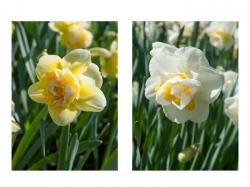Flower Bulb Of The Year: The Double-Flowering Daffodil
September 10, 2018 | 2 min to read

Big announcement: the double-flowering daffodil is the flower bulb of the year! Plant them now and they’ll give you that wonderful feeling of spring when they burst into bloom.
Spring
Daffodils? That’s right, daffodils. And double-flowering ones at that, so you’ll enjoy them twice as much. Double-flowering daffodils are typical spring flowers that will have you smiling as early as April when they are in bloom. What makes them so special is either that their cups are split into many petals or that the flower is simply filled with petals. Double-flowering daffodils are available in every yellow imaginable but also in cream, white and orange, and in every combination of these colours. And did you know that they’re perennial plants? That means enjoying them again the year thereafter!
In love
Where does the name ‘Narcissus’ (the scientific name for daffodils) actually come from? Its origin is a tragedy from ancient Greek mythology. When the classically handsome Narcissus saw his reflection in a pond, he fell hopelessly in love with himself. Because he couldn’t touch his reflection, he pined away out of frustration. His body disappeared to be replaced by a beautiful yellow flower: the Narcissus we now call a daffodil. And this year, it’s the double-flowering daffodil that’s being featured as the flower bulb of the year!
Good to know
Some double-flowering daffodil varieties are easier to find than others. This is because some are available in greater quantities than others. The varieties of double-flowering daffodils that are widely available (easier to find) are: ‘Replete’, ‘Abba’, ‘Ice King’ and ‘Rip van Winkle’.
Did you know that the double-flowering ‘Bridal Crown’ is used primarily as a pre-forced flower bulb in a pot? You can bring it inside or plant it in the garden.
More information about flower bulbs is available at bulb.com.
iBulb is the promotional agency for the flower bulb sector. iBulb promotes the use of flower bulbs, bulb flowers and bulbs in pots by means of worldwide PR activities and advertising campaigns. More information is available atwww.ibulb.org.
Source: iBulb
